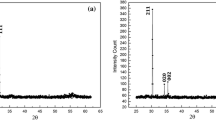Abstract
In order to make sure the co-operation of substrate temperatures and post-deposition annealing on the structure and performance of the a-SiOx:H for n-Cz-Si wafer passivation, three series a-SiOx:H films bifacial-deposited on n-Cz-Si wafers were made. In which, the first series was deposited at room temperature and post-deposition annealing with different temperature; the second series was deposited with different substrate temperature and without post-annealing; and the third series was deposited with different substrate temperature and post-annealed at the optimized 275 °C. Effective lifetime of the samples was tested by QSSPC method, and the imaginary part of dielectric constant (ε 2) and film properties of the films were analyzed by Spectroscopic Ellipsometry and Fourier Transform Infrared Spectroscopy. It is concluded that (1) the structure and passivation effect of a-SiOx:H films on n-Cz-Si wafer are sensitive to the substrate temperature and post-deposition annealing, and the optimum scheme is depositing the film at 100 °C and post-annealing the wafer at 275 °C; (2) the microstructure parameter R *of the a-SiOx:H is ~0.67 for the samples with the optimum passivation effect.






Similar content being viewed by others
References
H. Haibin, Z. Donghua, W. Yilin et al., Optimization and operation mechanism analysis of Cz-Si wafer passivation by a-SiOx:H film. J. Func. Mater. 9(45), 07001–07004 (2014)
K. Wakisaka, M. Taguchi, T. Sawada et al., More than 16% solar cells with a new “HIT” (doped a-Si/non doped a-Si/crystalline Si) structure. in Proceedings of the 22nd IEEE Photovoltaic Specialists Conference, Las Vegas, NV, USA, pp. 887–892 (1991)
J.A. Luna-López, G. García-Salgado, T. Díaz-Becerril et al., FTIR, AFM and PL properties of thin SiOx films deposited by HFCVD. Mater. Sci. Eng., B 174, 88–92 (2000)
T.H. Wang, E. Iwaniczko, M.R. Page et al., Effect of emitter deposition temperature on surface passivation in hot-wire chemical vapor deposited silicon heterojunction solar cells. Thin Solid Films 501, 284–287 (2006)
T. Mueller, S. Schwertheim, W.R. Fahrner, Crystalline silicon surface passivation by high-frequency plasma-enhanced chemical vapor-deposited nanocomposite silicon suboxides for solar cell applications. J. Appl. Phys. 107, 014504 (2010)
J. Sritharathikhun, C. Banerjee, M. Otsubo et al., Surface passivation of crystalline and polycrystalline silicon using hydrogenated amorphous silicon oxide film. Jpn. J. Appl. Phys. 6A(46), 3296–3300 (2007)
S.R. Jadkar, J.V. Sali, S.T. Kshirsagar, Influence of process pressure on HW-CVD deposited a-Si: H films. Sol. Energy Mater. Sol. Cells 85, 301–312 (2005)
A.F. Morral, P.R. Cabarrocas, Structure and hydrogen content of polymorphous silicon thin films studied by spectroscopic ellipsometry and nuclear measurements. Phys. Rev. B 69, 125307 (2004)
A.B. Sproul, Dimensionless solution of the equation describing the effect of surface recombination of carrier decay in semiconductors. J. Appl. Phys. 76, 2851–2854 (1994)
J. Brody, A. Rohatgi, A. Ristow, Review and comparison of equations relating bulk lifetime and surface recombination velocity to effective lifetime measured under flash lamp illumination. Sol. Energy Mater. Sol. Cells 77, 293–301 (2003)
T. Mueller, S. Schwertheim, W.R. Fahmer. Application of wide-band gap hydrogenated amorphous silicon oxide layers to heterojunction solar cells for high quality passivation. IEEE, (2008). doi:10.1109/PVSC.2008.4922792
D. Levi, E. Iwaniczko, M. Page et al., Silicon heterojunction solar cell characterization and optimization using in situ and ex situ spectroscopic ellipsometry, in IEEE, Hawaii (2006). doi:10.1109/WCPEC.2006.279828
T. Mueller, J. Wong, A.G. Aberle, Heterojunction silicon wafer solar cells using amorphous silicon suboxides for interface passivation. Energy Proced. 15, 97–106 (2012)
D.H. Levi, C.W. Teplin, E. Iwaniczko et al., Real-time spectroscopic ellipsometry studies of the growth of amorphous and epitaxial silicon for photovoltaic applications. J. Vac. Sci. Technol. 24(4), 1676–1683 (2006)
J.D. Ouwens, R. Schrop, Hydrogen microstructure in hydrogenated amorphous silicon. Phys. Rev. B 54(24), 17759 (1996)
I. Roca, P. Cabarrocas, C. Clerc, I. Fontcuberta, A. Morral, Structure and hydrogen content of polymorphous silicon thin films studied by spectroscopic ellipsometry and nuclear measurements. Phys. Rev. B 69(12), 125307 (2004)
J.-C. Hsiao, C.-H. Chen, C.-C. Lin et al., Effect of hydrogen dilution on the intrinsic a-Si: H film of the heterojunction silicon-based solar cell. J. Electrochem. Soc. 158(9), H876–H878 (2011)
Acknowledgments
This work was supported by the National Natural Science Foundation of China (Grant Nos. 61306084, 61464007), the Specialized Research Fund for the doctoral Program of Higher Education of China (Grant No. 20113601120006), and the Science and Technology Project of Education Department of Jiangxi Province, China (Grant No. GJJ13010).
Author information
Authors and Affiliations
Corresponding author
Rights and permissions
About this article
Cite this article
He, Y., Huang, H., Zhou, L. et al. Effect of substrate temperature and post-deposition annealing on intrinsic a-SiOx:H film for n-Cz-Si wafer passivation. J Mater Sci: Mater Electron 27, 4659–4664 (2016). https://doi.org/10.1007/s10854-016-4344-5
Received:
Accepted:
Published:
Issue Date:
DOI: https://doi.org/10.1007/s10854-016-4344-5




